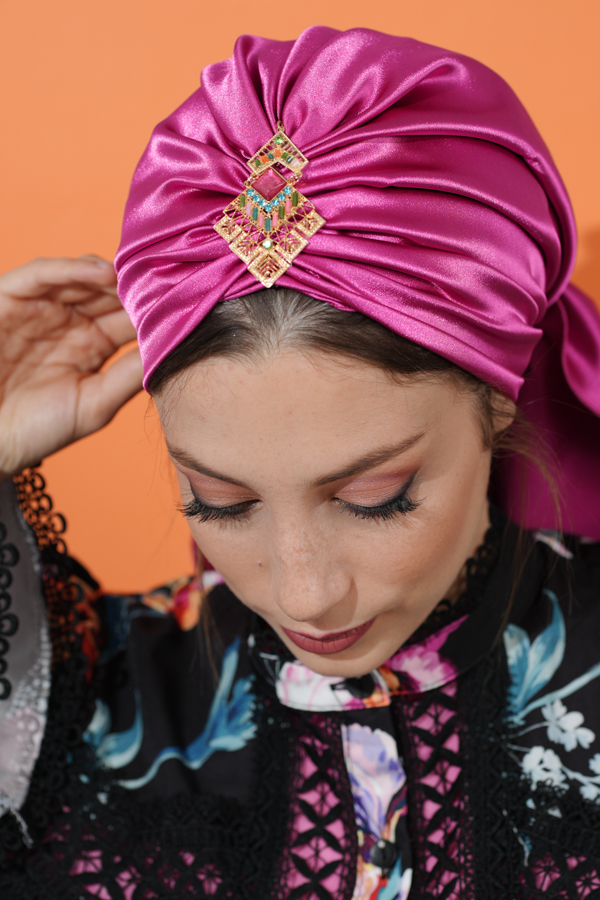Torah-observant Orthodox Jewish women are required to cover their heads after they get married, but there is still some debate about what the tzniut practice entails.
There are also different opinions among Reformed and Conservative Jewish communities as to whether the obligation to cover one’s head is Dat Moshe or Dat Yehudi—is it immutable divine law or community tradition?
The good news is that no matter your personal beliefs, many attractive Jewish women’s hair covering options are suitable for any occasion—every day, evening, or special event, full or partial covering.
Here, we will take a closer look at some of the most popular hair covering choices for today’s fashionable Orthodox Jewish women.
Tichel: Traditional Daily Headscarves
Also called a tichel in Yiddish or a mitpachat in Hebrew, a daily headscarf is the most common way to be both beautiful and modest. These scarves can be as simple as plain-colored cotton kerchiefs, or they can be multicolored and made from several fabrics.
These Jewish head covering scarves typically come in two types:
- Sinar Tichel—Also called an “apron” tichel because of their similar shapes, a sinar tichel is a square piece of fabric with two attached bands that wrap around the head.
- A Full-Cover Tichel—A solid piece of fabric—square, rectangular, or triangular—that is folded and tied to completely cover all of a married woman’s hair.
A tichel is one of the very versatile Jewish head covering scarves and can be worn in many different ways, based on the tying technique employed, simple or elaborate, and depending on your mood and the occasion. In other words, it lets you express your individual personality.
Tichels can be made of any material, from plain cotton to silk to modern-day synthetics. A tichel made from cashmere wool is commonly referred to as a pashmina.
Women who want to cover their hair completely will often wear a boubou or snood under their tichel to prevent hair accidentally slipping out from underneath.
Besides preserving modesty, these items also add volume. Similarly, many women choose to strategically wear a velvet headband beneath their scarf to keep it in place throughout the day.
Turbans: An Elegant Option
A turban is a Jewish head covering scarf with a strip of cloth you put in place by winding rather than wrapping and tying. It is an excellent alternative for women who want to mix it up and try a new look other than scarves.
Best of all, there are now pull-on styles that deliver the distinctive look and attitude of a turban without the need for time-consuming wrapping.
Women who wear this Jewish women head covering exude confidence and elegance with every step. Picture a modern-day Nora Desmond or Gloria Swanson, and you will have a pretty good idea of the grace and élan projected.
Turbans are chic and versatile, and they pair equally well with casual outfits, business attire, and even formal wear. They are an essential accessory for any woman wanting a fashionable hair covering.
Hats: The Hair Covering Option You Should Consider
Another attractive head covering for Jewish women that is follows Dat Moshe and Dat Yehudi is a hat. Ladies can wear this option either with or without an underlying scarf. Many Orthodox women never even consider this fun and modern style choice.
As long as it can be worn in such a way to conceal the hair, any style of hat can be appropriate—cloche, pillbox, Bretton, or skimmer. Formal or fun, whatever your personal fashion sense and whatever the particular situation, there is always a hat that is right for you.
Berets: Tzniut Can Be Fun
Easy to throw on, a beret is a perfect choice for the Jewish woman on the go who is too busy to spend a lot of time wrapping or winding. Just tuck in your hair, secure the beret with a few pins, and you are ready in a flash to meet the day.
Here’s a fun fact—although many people associate berets with early 20th-century France, this style of headgear has actually been worn in Europe for thousands of years, traceable all the way back to the Bronze Age.
Headbands: The Modern Choice
If your beliefs only require you to cover some of your hair, then the right headband can be the Jewish women’s head covering that you have been looking for. A headband can be a simple, hassle-free testament to one’s cultural identity and pride.
This is especially true for women from Reform and Conservative communities where the accepted standards of modesty have evolved closer in step with the modern world.
Many women in these communities do not cover their hair on a daily basis, and even when they do, they only do so symbolically, wearing a small covering while leaving most of their hair visible.
In other words, a colorful printed headband might be the perfect option for the modern Jewish woman.
The Bottom Line About Hair Coverings for Jewish Women
Covering one’s hair is a deep and very personal mitzvah. In today’s world, the good news is a woman has many wonderful options, so there is no need to feel limited in any way. You have more choices today than at any other point in history. Tzniut is easier than ever before.
So, which style is right for you?
Why not ALL of them?
Keep in mind, the question at hand is not one of tichels versus turbans or hats versus scarves. It does not have to be an either-or situation. The only question a woman really needs to ask herself is: Which hair coverings make her feel and look her best?
In the end, how you choose to cover your hair reflects not just your beliefs and pride in your heritage but also your sense of personal style and self-expression.
Observing tzniut does not preclude feeling both beautiful and confident. Experiment with different head coverings, tying techniques, and outfits until you find the look that works for YOU.








